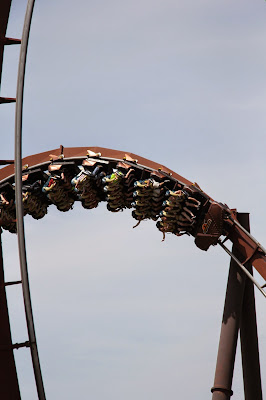The Grand Staircase in the Titanic Museum.
Branson Landing water show along Lake Taneycomo.
WildFire ride at Silver Dollar City.
One of 12 waterfalls in Dogwood Canyon Nature Park.
Sisters June and Joan stretch peanut
brittle at Copper Kettle Candies in Silver Dollar City. June, 71, has
worked here since 1968.
Story & Photos By
Stan Wawer
Branson, MO,
once known as Disneyland for Seniors, has evolved into a destination with
something for all ages. It has become a pretty cool place with lots to see and
lots to do.
“When
Branson opened, the average age of visitors was 65,” said Lynn Berry, director
of communications for Branson’s Convention & Visitors Bureau. “Today, the
average age is 57; in June, July and August it’s 41.”
During my
stay in Branson in early May, I saw more families than I did seniors. Branson
was way more than I expected. Branson offers live shows, outdoor adventure and
family fun. It all starts with Branson Landing along Lake Taneycomo and reaches
out to the theater district, Silver Dollar City and the stunning Dogwood Canyon
Nature Park.
Branson
Landing has a variety of high-end shops, including Bass Pro Shops White River
Outpost on the south end of Branson Landing. Bass Pro Shops Inc. corporate
office and headquarters are located in nearby Springfield.
I spent an
exciting day at Dogwood Canyon Nature Park following a morning of ziplining the
eight-stage Branson Zipline Canopy Tours. Dogwood Canyon is waterfalls heaven.
The park covers 10,000 acres of pristine Ozark Mountain landscape. There are
miles of crystal-clear trout streams, dozens of cascading waterfalls, unique
hand-built bridges and bottomless blue-green pools. The park continues into
Arkansas where I saw elk, bison and Texas longhorn steers. I even got to
scratch a female elk behind the ear and under her chin.
Bass Pro
Shops’ founder Johnny Morris acquired the land in 1990. The Dogwood Canyon
Foundation, a non-profit organization dedicated to preserving and protecting
the canyon’s natural plant and wildlife environment, manages the park. The park
offers trail rides, biking, wildlife tram tours, private guided jeep tours,
Segway tours, fishing and a cattle drive. A new working gristmill, with general
store, restaurant, bike barn and patio area will open later this year. Hope
Wilderness Chapel, which hosts weddings, is a replica of churches from the
1800s.
Silver
Dollar City is an 1880s-style theme park much like Southern California’s
Knott’s Berry Farm. The park features a dozen restaurants, 40 live shows daily,
60 unique shops and 30 rides and attractions, several rides of the
white-knuckle variety. Craftsmen demonstrate the art of woodcarving,
glassblowing, pottery, blacksmithing and candy making.
In June, Silver
Dollar City features the Harlem Globetrotters headlining and performing in an
exhibition of basketball expertise. They will star in 30-minute performances
presented three times daily for six weeks.
Branson’s
theaters will host a number of big names in 2015, including Charlie Daniels,
Johnny Mathis, Little River Band and the Oak Ridge Boys in the Oak Ridge
Theatre. Andy Williams Moon River Theatre hosts Rick Springfield, B.J. Thomas,
Moe Bandy and Joe Stampley. Moon River also hosts regulars the Osmond Brothers,
the Lennon Sisters, illusionist Rick Thomas and Mary Wilson of The Supremes.
Acrobats of
Shanghai is one of Branson’s biggest attractions. I saw them perform on a trip
to Shanghai in 2006 and the smaller group in Branson. They will leave you
spellbound.
The Titanic,
the world’s largest museum attraction, is a must see. This is an incredible museum
and one I highly recommend. The museum has more than 400 artifacts, 20
galleries and 2,208 stories to share. Since the venue opened in 2006, it has
received more than 5.5 million visitors. If you love history, this place is
going to make you drool.
The museum is a half-scale replica of
the original ill-fated cruise ship that hit an iceberg south of Newfoundland
and sank on April 25, 1912. Of the 2,223 passengers on board, 1,517 died.
Boarding daily starts at 9 a.m. The Titanic Museum is open year round.
There are
many excellent restaurants in Branson. I dined at the magnificent Chateau on
the Lake Restaurant overlooking Table Rock Lake. It started out with a great
sunset over the lake, a filet mignon dinner, excellent malbec wine and a
chocolate dessert to die for. The hotel’s atrium with waterfalls is another
stunner. Branson also offers camping, boating, the Branson Scenic Ozark Zephyr
Railway (www.bransontrain.com) and golf.
As I said
earlier in this story, Branson isn’t just for seniors anymore, it is now an
every age go-to destination.
If you go
Most
visitors to Branson fly into Springfield-Branson National Airport. It is about
50 miles north of Branson. It offers dozens of daily flights connecting to
eight international airports via five airlines — Allegiant Air, American,
Delta, Northwest and United. Branson Airport opened in 2009. It is where many
private planes land. Check at FlyBranson.com. I flew American to Springfield,
with a plane change in Dallas-Fort Worth. Rental cars are available at both
airports.
Where to Stay
There are a number of hotels, motels, inns and resorts in the
Branson area. I stayed at the Hilton Promenade at Branson Landing
((hiltonsofbranson.com). It is across Main Street from the Hilton Branson
Convention Center Hotel (hiltonofbranson.com). Chateau On The Lake Resort &
Spa is four diamonds, with an excellent restaurant a breathtaking view of Table
Rock Lake (ChateauOnTheLake.com).
All information is accurate at
the time of publication but prices, dates and other details are all subject to
change. Confirm all information before making any travel arrangements.
Travel Editor Stan Wawer is a La
Verne resident, a member of the Society of American Travel Writers and editor
of his own travel blog, www.travelwithstan.blogspot.com. Address all travel related
questions to his blog. His travel Facebook page is
www.facebook.com/TravelWithStan.

















